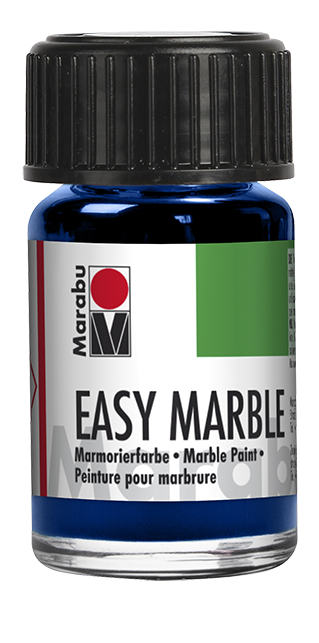Marabu easy marble
dark ultramarine 055, 15 ml
13050039055


Creating marble effects, easier than ever before: Drip, dip, done! Quick-drying. Ideal for creating immersion marble effects on plastic, glass, acrylic plastic, wood, papier mâché, blown eggs, metal, polystyrene and for marble effects on paper.
Instructions for use:
Effect and white pigments in neon, standard, metallic and pastel shades settle heavily to the bottom. You should therefore shake them well or remove the drip cap and briefly stir the paint.
paper, rice paper
Marble effects can be created on paper up to DIN A5 with easy marble using just water, without a special marble effect base coat. Rice paper and other absorbent papers produce particularly beautiful effects. Instead of immersing it, gently place the paper on the surface of the water, let it absorb the water briefly and then remove it carefully. Smooth papers have to be dragged below the surface of the water during removal to prevent a second layer of paint from settling. Wallpaper paste should be used as a marble effect base coat for paper formats between DIN A5 and DIN A4. This prevents the paper from sinking too fast and also allows exact marble effect patterns.
Fabric and silk
Marble effects on water can also be achieved on small sections of silk and thin fabrics up to DIN A5. We recommend a wallpaper paste bath for larger sizes between DIN A5 and DIN A5. Always carry out a patch test for silk and fabrics, as not all fabrics are suitable. Both materials with marble effects are not washable.
Marble effect with marble effect base coat (wallpaper paste)
Preparation:
Creating a marble effect base coat on wallpaper paste basis: Whisk 1 level tablespoon of wallpaper paste into 1 litre of cold water. Leave to soak over night.
Creating the marble effect:
1. Place the wallpaper paste into a shallow bowl. Break up any air bubbles in the marble effect base with a needle to avoid the bubbles from transferring onto the paper/silk/fabric.
2. Drip the paint onto the surface of the paste directly from the drip jar. 2-3 colours are ideal. The more colour you use the more intensive the marble effect will be.
3. Immediately use a wooden stick (tooth pick) or a comb to create a marble effect pattern.
4. Now gently place the paper/silk/fabric on the pattern. For fabrics and absorbent papers, wait for a moment to let the material absorb the paint.
5. Now slowly remove the paper/silk/fabric from the marble effect base and immediately rinse off any excess paste under running cold water. Do not rub. Leave to dry. Finished!
Finishing:
Afterwards carefully remove the entire excess paint film with a sheet of paper (using a paper edge). Paint residue on the surface of the water prevents the new colour from spreading evenly. Replace the paste bath after approx. 7-10 marble effect cycles.
Immersion marble effect:
Preparation:
Fill container (e.g. a large yoghurt container) with cold water. Ensure that the container is large enough to immerse the entire object. The container cannot be re-used for other purposes after being used for the marble effect as it will not be possible to clean it completely. Place the object (e.g. ball) on a wooden stick (toothpick).
Creating the marble effect:
1. Drip the paint onto the surface of the water directly from the drip jar. 2-3 colours are ideal. The more colour you use the more intensive the marble effect will be.
2. Immediately use a wooden stick (tooth pick) to create a marble effect pattern.
3. Now immerse the object into the water slowly and pull it out again quickly. Leave to dry. Done!
Finishing:
Afterwards carefully remove the entire excess paint film from the surface of the water with a sheet of paper (using a paper edge). Paint residue on the surface of the water prevents the new colour from spreading evenly.
Shaking of marbling paint Easy marble
Effect and white pigments in neon, metallic and pastel shades settle heavily to the bottom. You should therefore shake them well or remove the drip cap and briefly stir the paint.
• More paint and a cooler water temperature extend the drying time of the paint film on the surface of the water.
• When adding marble effects to polystyrene, only use a small amount of paint.
• The more paint you use, the more intensive the marble effect will be. The fresher the paint, the better the result.
• If paint droplets are added with too much of a flourish or too slowly, air bubbles can form on the marbled surface, which result in white spots when the object dries.
• Pre-clean smooth surfaces such as metal or glass with alcohol.
• Standard and neon paints are only suitable for light backgrounds. Pastel and metallic shades can also be used on dark objects. Crystal clear is ideal for monochrome marbling.
• Not food safe or washable
• For plastic, glass, wood, polystyrene, fabric, paper, metal